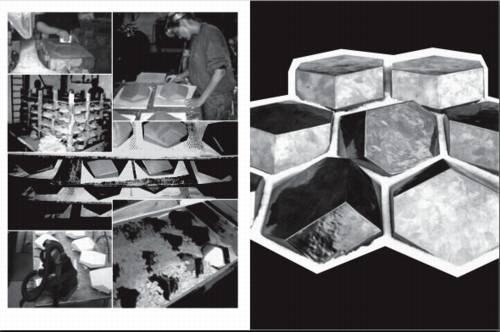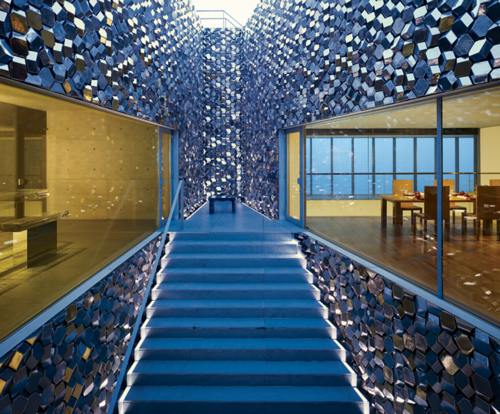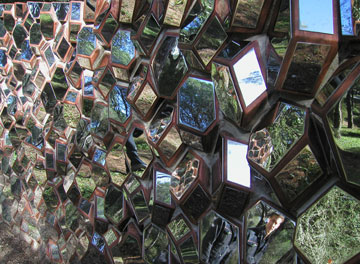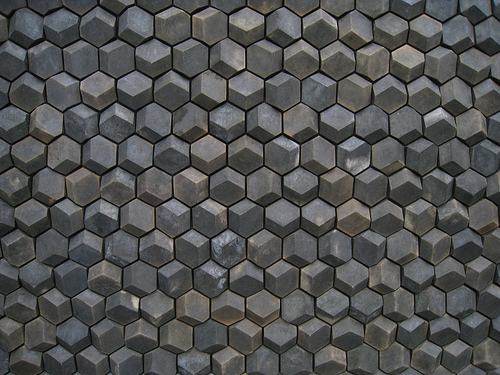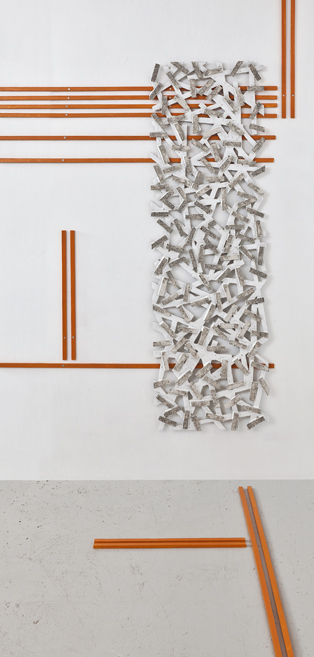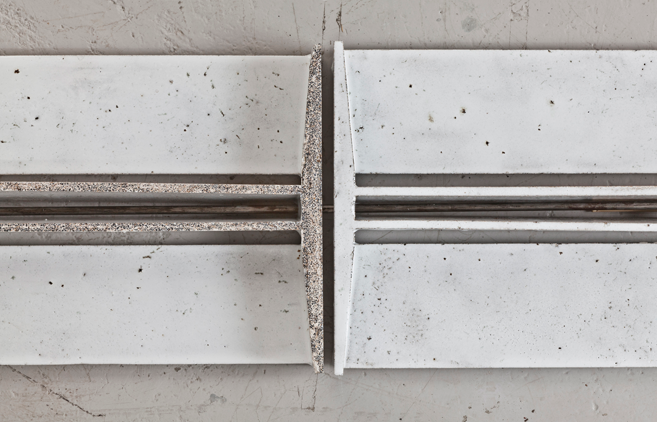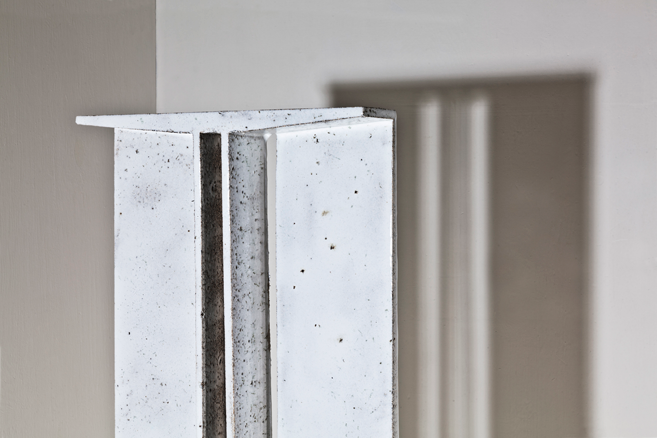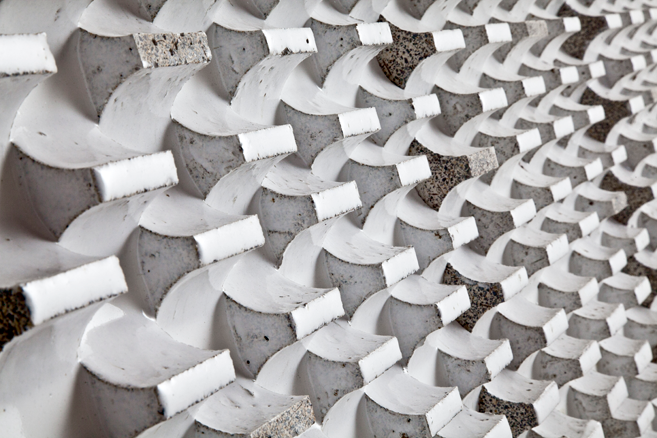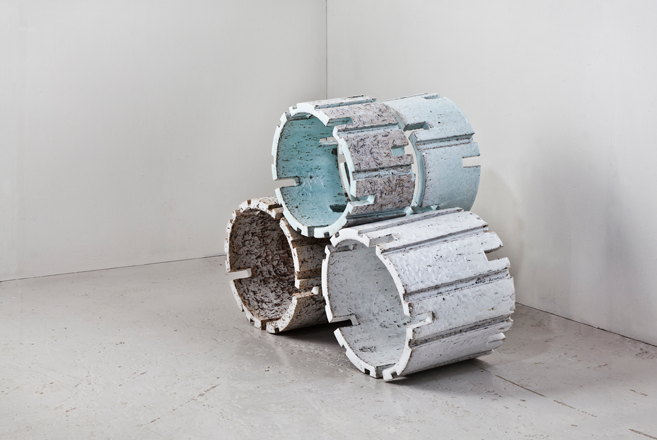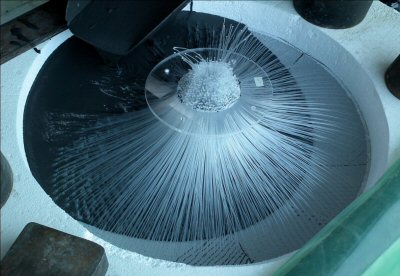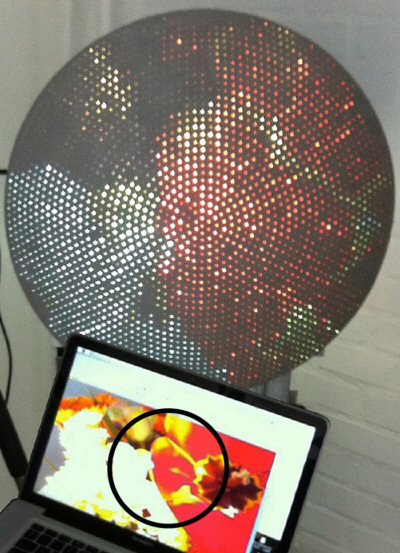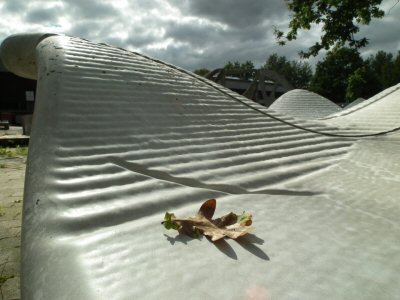This post is an attempt to describe a concept that I have coined – stereogeneity – or concrete as a material and as process. If you wonder how that stereo word has any relation with concrete – it may be good to know that stereophonic or stereo sound means solid sound – because stereos is Greek for solid or hard and phone is voice in Greek (news to me).
While we may forget that sound is solid – there is rarely any forgetting that of concrete. So, often, concrete is explained in simple ways as the contrast between liquid and solid. Architects explain their fascination with the material because it, at least conceptually, is easily molded like a piece of clay in the hand. Yet the truth is, of course, more complex.
Multiple design tasks for concrete
For even minimal construction projects such as student workshops this means that they have to design structural formwork principles, the concrete object/structure, as well as the process of construction – and all simultaneously. I guess this focus on the relationship between architectural technology and the expression of construction and materials is somewhat old school tectonics. But I love it – call it tectonics or not, this approach to architecture is bound to a Scandinavian pragmatic and sober tradition in design and construction. – and then it is the foundation for constructing fabric formed concrete. Everything shows – the potential as well as the ‘danger’ when the slightest pinches, the shape and position of formtie impactos, - and when things go slightly wrong. – it all shows.

[Detail of the Walking Chromosome Column by yours Concretely, 2013. The formwork is closed using a seam technique and the fabric is sweating excess mix water under the hydrostatic pressure of the freshly poured concrete]
Take off the aesthetics hat and wear what?
In order to discuss as well as develop the architectural potentials for fabric formwork it has proved necessary to define a concept to embrace this relation rather than the concrete 'results'. With only a few built examples of fabric formed concrete and thus no context for a judgement, I am really reluctant to use aesthetics or beauty as factors for evalation here because it is not so relevant if you love or are repulsed by strange bulging concrete. If you do not like it, fine, but wearing the habitual hat of the aesthetic limits the scope of any investigation.
Concrete-ness?
The pioneer in fabric formwork, Mark West, once referenced an essay by American art critic and poet Peter Schjeldahl in which he describes concrete-ness and the presence and personality and intrinsic dichotomy of the liquid and solid characteristics of concrete.
“
Concrete is the most careless, promiscuous stuff until it is committed, when it becomes fa¬natically adamant. Liquid rock, concrete is born under a sign of paradox and does not care […]
Concrete hardens in the shape of whatever container received its flow, its momentary sensual abandon in thoughtless submission to half-loved gravity. Once it has set, what a difference! Concrete becomes adamant, fanatical, a Puritan, a rock, Robespierre – the divinity! – of the shape it comprises, be the shape a glopped heap on the ground or a concert hall, ridiculous or sublime.”
Right, liquid concrete is promiscuous – it lets itself embrace in any shape and caress by any material formwork. Solid concrete on the other hand is not to be messed with. While describing each material extreme Scheldal’s approach to concrete-ness does not quite encompass the techniques, intentions, nor materials of getting from one condition to the other.
Concrete in Greek
I turned to my friend, the Greek author Iosif Alygizakis, to help me out. With his kind assistance I wanted to coin a term that would encompass how or that concrete when cured and solid appears with signs of its becoming.
Why Greek you may wonder?? – well there are two direct reasons. – I have been studying the theories of Gottfried Semper and here concrete lies between a number of his schematic labels for materials and procedures – exactly due to the different materials, techniques and conditions of the material. The concept of stereotomi (cut stone or ‘mass’) is often associated with brickwork. Tectonic with timber, Ceramics with clay, and textile with weavings or the clad/draped façade.
Greek in many tongues
The other reason is very pragmatic – for the longest time I did not know which language I was writing my PhD dissertation… Danish or English. Greek is neutral in the sense that it is used in both languages and always means the same.
Iosif dissected words and meaning through almost mathematical methods and summa summarum he created a new word based on the words for solid
stereos and for becoming - i.e. to begin to be,
genés
Stereo|genés
Στερεό|γενές written without the | in the middle
Genés – not genesis
Genés is an ending – which comes the verb:
ginomai [ginomæ]
-
it means: to become – it means – to be in the process of becoming something, to begin to be
-
and – becoming what?? – well, StereoThe Gr.
Ginomai refers to procedure of becoming. It describes the process of the becoming of – through a procedure.
What does it become –
stereo – Gr. solid – by this formulation we don't need the word fluid, liquid.
It is absolute
If it becomes solid – stereo – so, of course, it was totally understandably liquid
Of factual ideas or constructural items in order for them to become something else, something – as an aftermath as a product. – important – it is through a series of manufacture.
Stereo-geneous – the English – an adjective
[above is basically notes taken from Iosif explaining the meaning of the words and their connection]
Petro or stereo
In the US there seem to be a use of the word cultured stone as a commercial word for concrete for design and architecture – and perhaps especially for home owners. – liquid stone and cultured stone – the words can be found in Iosif ‘s other suggestion
petrogenés,
petro is Greek for stone. I went for stereos because, well – concrete is more than stone to me and I liked how it sounded too.
[Detail of striking the formwork for the Walking Chromosome Column by yours Concretely, TEK1 2013. The seam as well as the fabric have left stereogeneous traces.
Sekler's tectonic
The discussion of concrete as material and process is not new - and also the relationship between structural principles, materials, techniques and construction is overly described, I know. Stereogeneity is to concrete, especially in situ concrete, what Eduards Sekler’s use of the term tectonic is to the overall relation is between structural principles, techniques and the expressed physical manifestation.
So, in English, stereogenés is stereogeneity. The value of concrete as a substance is stereogeneous – it is something that develops from a liquid to a solid state.
And how to use this?? Well, in my dissertation work I have developed the use the term by discussing qualities in built concrete works by architects such as Louis Kahn, Frank Lloyd Wright, Jean Nouvel and Peter Zumthor – to describe the relation between process and materiality. For the analytical cases of fabric formed concrete I have been even more specific and looked at the role of particular details in construction: The form-tie, the frame, and the textile. Furthermore, the aspect of conditions or states between liquid and solid has allowed to focus on a particular state in the 'becoming' of the analytical cases, say the intentions behind experiments, the particular technique behind a detail versus its stereogeneous consequence at the end.
– I hope to return to this topic and the cases in a stereogeneous light in future posts.
References
Manelius, Anne-Mette (2012)
Fabric Formwork - Investigations into Steregeneity and Formwork Tectonics in Architectural Constructions, PhD dissertation, Royal Danish Academy of Fine Arts, School of Architecture.
Schjeldahl, Peter (1994)
Columns & Catalogues. Great Barrington MA: The Figures.
Sekler, Eduard. “Structure, Construction, Tectonics.” In
Structure in Art and Science, edited by Gyorgy Kepes, 89- 95. New York: George Braziller, 1965.
As always, please accredit me if you use any of the original points or images from this post. I'd love to know how you used or applied it and what your think.
